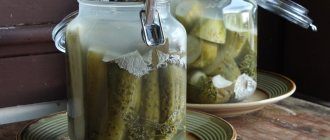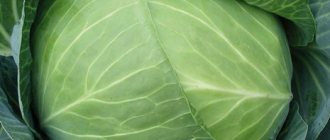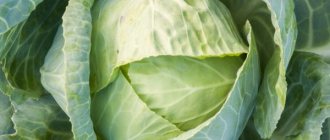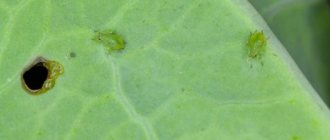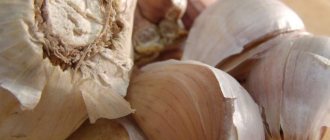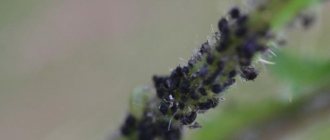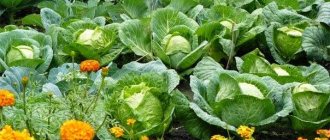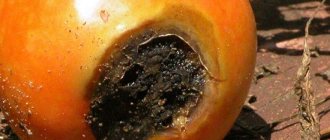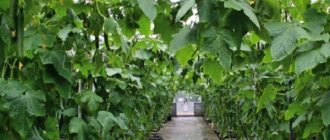Cause of black leaves
Most often, the cause of spoiled vegetables is vascular or so-called mucous bacteriosis. In this case, the veins of the cabbage leaf become black, resulting in a black mesh. The leaves may also wrinkle, dry out and become transparent. But there are a number of other factors that can lead to this problem. Let's look at them in more detail below.
Causes of blackness in a head of cabbage:
- unsuitable storage conditions for vegetables;
- damage by various diseases, such as gray rot, fusarium wilt, alterniosis.
If we are talking about improper storage of vegetables, then this can happen as a result of low access of oxygen, as well as the development of certain harmful microorganisms.
Gray rot causes an unpleasant moldy odor and a gray coating. It is important to remove all affected areas in a timely manner, otherwise damage to all products cannot be avoided. If the rotting leaves are removed in time and the head of cabbage is washed well, then the cabbage can be eaten.
Fusarium wilt can occur in vegetables that grew in dry weather. As a result, you can see darkened spots on the blood vessels. As a result, cabbage becomes completely unsuitable for food.
Alterniosis leads to very rapid rotting. They begin to easily separate from the head of cabbage.
Why cabbage turns black during storage: main reasons
The main factors leading to blackening of cabbage heads, both outside and inside, include the most common:
- The vegetable crop was selected for storage already showing signs of external damage (spots, cracks, deformation of the fruit). To avoid rapid deterioration during subsequent storage, when selecting forks, you should visually ensure that there is no external damage. The end of the cut stem (stem) should be even, smooth, without changing structure or color. The cover sheets should be hard (but not dry), fit tightly to the fork, and have a rich color (inherent in a particular variety or hybrid).
- The appearance of darkening of the internal structure of the vegetable, which is revealed only on the cut and is usually caused by diseases that affected the plant at the stage of vegetative development in the ridges. The main ailments of the vegetable are: gray rot (fungal infection is identified by the presence of a gray coating and the characteristic smell of mold), fusarium wilt (mainly this disease affects forks formed in dry conditions, without sufficient watering, and it can be recognized by the condition of the vessels on the cut - they will have characteristic brown dots), Alternaria (the disease manifests itself in the form of a rapid process of rotting of the entire leaf volume of the vegetable, as a result of which the leaves can be very easily separated from each other).
- Failure to comply with the vegetable storage regime itself, which results in a decrease in oxygen levels and a violation of the temperature regime, which entails a change in humidity parameters. All this leads to the rapid proliferation of pathogenic microorganisms, which in the process of their life activity make the vegetable unsuitable for further consumption.
How to deal with blackening of leaves
Knowing why cabbage leaves turn black inside the head of cabbage, you can choose the most appropriate method of prevention or method of dealing with a particular problem.
If the problem is a disease, then only proper prevention can cope with it, even before planting vegetables.
It is important to spray the plants with preparations that contain copper, as well as feed them. Various growth stimulants can also help, for example, a drug such as Novosil.
If the problem is improper storage of vegetables, then there are a number of methods that will help increase the shelf life of cabbage. So, the normal temperature for it is 1-5 degrees. Modern refrigerators have special areas designed for vegetables. Otherwise, you need to select the bottom shelf and set the lowest temperature. By the way, not all heads of cabbage can be stored. For these purposes, the vegetable should not have any mechanical damage, the leaves on top should fit tightly to the head of cabbage, and its structure should be dense, without cracks, and healthy in appearance. The heads of cabbage are well dried.
You can store products in a plastic or paper bag, as well as in cling film. There should be no air between the film and the vegetable. So cabbage can be stored for up to 1 month. Cabbage can also be frozen and dried.
Shredded vegetables can be stored for a long time in a plastic bag or in special food containers. This way you will definitely avoid its damage.
Kohlrabi, broccoli, white cabbage - how to choose fresh cabbage and cook it in an unusual way
Cabbage is one of the most popular fall fruits. It is not only tasty, but also a very healthy product - it contains many vitamins and substances that cannot be found in most conventional products. Chef Yulia Trikisha told how it can be prepared in an unusual way.
White cabbage
This is a universal type of cabbage, because it can be eaten either fresh or stewed, fried, or boiled. In addition, this is the only type of cabbage that can be fermented, salted and pickled.
How to choose The maturity of white cabbage can be determined by squeezing the head with your hands. If it presses through, the cabbage is not fully ripe. Lack of elasticity is a sign of old cabbage; therefore, when salted, such a vegetable will become soggy and the dish will turn out to be stringy. A dense head is an indicator of the juiciness of the vegetable and the fact that it will be stored for a long time. A good “white cabbage” should not have spots or black spots - this is a sign of fungus. And if the head of cabbage is cracked, it means there was a lot of moisture when it was grown, so it will turn out to be tasteless.
Pay attention to the stalk. If a lot of leaves were cut from it, discard such a vegetable, because this is how sellers “rejuvenated” stale cabbage. The larger and heavier the head of cabbage, the tastier it is. You should not choose small heads weighing up to 1 kg. Such cabbage was harvested from the field early and did not have time to collect juice.
Quick pickled assortment - recipe
Dill seeds - 1 tbsp. l.
Apple (Antonovka) - 5 pcs.
Directions : Remove the outer leaves from the cabbage, wash them and set aside. Chop the cabbage and grate the carrots on a coarse grater.
Mix carrots with cabbage in a deep bowl, sprinkle with salt and mash until juice appears. Lightly grind the dill seeds in a mortar and add to the cabbage. Add cranberries. Wash the apples, cut them in half, remove the core and add to the cabbage. Stir.
Place the reserved outer leaves on top of the shredded cabbage. Cover the basin with gauze, place a large plate on it and place pressure (for example, a three-liter jar of water).
Cabbage should stand under pressure for three to four days at room temperature. During this time, pierce the cabbage with a wooden spoon twice a day to release the gas formed during fermentation. After four days, transfer the cabbage to jars and put it in the refrigerator. The cabbage will be completely ready in 10 days.
This is interesting: Vacuum removal of blackheads
Broccoli is good boiled and fried in breadcrumbs. Vegetable soup, puree soup and cream soup are cooked with it, and added to pizza. This type of cabbage goes well with pasta, garlic and anchovies.
How to choose Unripe cabbage with a delicate taste can be easily recognized by its dense, unblown inflorescences. If the buds are loose, the broccoli has been sitting for a long time and will not be juicy. Cabbage that was picked young will have a thin stem; if the cut area is large in diameter, 1 cm, the broccoli is overripe and will be tough. Juicy cabbage without a pungent odor will be dark green in color, and the size of the inflorescence should be approximately 10–15 cm.
Broccoli soup with cheese - recipe
Olive oil - 2 tbsp. l.
Potatoes - 2 pcs.
Broccoli – 250 g
Vegetable broth - 1 l
Paprika, salt, pepper - to taste
How to cook : Cut the potatoes into cubes measuring 1x1 cm, finely chop the onion. Pour oil into a thick-bottomed pan, add potatoes and onions and fry, stirring, for 5-7 minutes.
Separate the cabbage into inflorescences. Grate the cheese on a coarse grater. Add cabbage and cheese to the pan, fill with vegetable broth. Bring to a boil and simmer for 20-25 minutes until the potatoes are tender.
Puree the soup with a blender and add cream, return to heat. Add salt and pepper and bring to a boil. Pour into bowls and sprinkle with paprika.
Brussels sprouts
Brussels sprouts are delicious boiled or stewed. It is baked in cream, placed in vegetable broths and fried with garlic. If the Brussels sprouts are a little bitter, boil them in salted water with a teaspoon of lemon juice.
Brussels sprouts need to be prepared in two stages. First, it is lightly boiled for 5–7 minutes, and then stewed, fried or baked. To ensure that the head of cabbage cooks evenly, make a cross-shaped cut at the base before throwing it into boiling water. If you plan to serve boiled Brussels sprouts as a side dish, after boiling, place them in ice water for 2-3 minutes. It will turn bright green.
How to choose Heads of cabbage up to 2 cm in diameter will be tastier and juicier. They should be dense and without yellowness. Choose heads of cabbage without escaping juice. Moisture on the cabbage is a sign that it has begun to rot. The heads of cabbage on the branch will be stored longer.
Brussels sprouts with bacon – recipe
Brussels sprouts – 400 g
Olive oil - 2 tbsp. l.
Lemon juice - 1 tbsp. l.
How to cook : Cut the stalks from the heads of cabbage and boil for 5 minutes in salted water. Cut the bacon into thin slices and fry in olive oil on both sides. Mix the cooled cabbage with bacon and fry, stirring, for three minutes. Salt and sprinkle with lemon juice.
Kohlrabi is made into puree soup, boiled, baked and stuffed. Salads are made from fresh kohlrabi. It goes well in one dish with fresh carrots, lemon juice, sour cream and garlic, soy sauce, chicken, fish, shrimp, peanuts, tomatoes and tofu. If you peel and boil kohlrabi, you can make a puree from it that tastes like potato puree. This cabbage goes well with creamy sauces, such as bechamel.
How to choose Small kohlrabi fruits will be tastier - approximately 5–7 cm in diameter and weighing up to 150 g. Large ones may have a woody taste and be tough. Juicy fruits are heavy in weight. And their freshness will be shown by dark green leaves. Good cabbage should not have cracks or stains; the skin should be scratchable with a fingernail.
Stuffed kohlrabi - recipe
Champignons – 100 g
Chicken fillet – 100 g
Salt, pepper, oregano - to taste
Tomato paste - 85 g
How to cook : Wash the kohlrabi thoroughly, cut off the top and use a spoon to remove the middle to form a pot. Boil the cabbage form in salted water for 15 minutes.
Finely chop the fillet, cut the champignons into slices, and chop the onion. Fry all filling ingredients for 7-10 minutes.
Finely chop half the kohlrabi pulp, mix with minced meat, salt and pepper. Fill the cabbage molds with minced meat and pour over the cream.
Place the kohlrabi in a baking dish. Mix tomato paste and cream and pour the resulting sauce over the cabbage. Cover the pan with foil and place in the oven at 180°C for 25 minutes. Remove the foil and bake for another 10 minutes until the cabbage is lightly browned.
Red cabbage
Red cabbage can be used in the same way as white cabbage. True, after heat treatment it loses its brightness. Most often, red cabbage is placed in salads, and to prevent it from fading, it is seasoned with lemon juice or vinegar. You can make cabbage rolls from this cabbage, stew them and add them to soups. It goes well with apples, so it is stewed with these fruits, adding a little red wine.
How to Select Fresh red cabbage should not have dark spots, and the top leaves should be juicy and firm. The heavier the head of red cabbage, the juicier and sweeter it will be.
Is it possible to eat spoiled heads of cabbage?
Depending on the type of cabbage affected, it may still remain edible or become inedible. So, if the cause of the damage is improper storage, then sooner or later the vegetable completely loses all its benefits and becomes tasteless. This product can no longer be eaten.
If it is affected by gray rot, then thoroughly cleaning the head of cabbage can help, after which it can be eaten.
Now you know why cabbage leaves turn black inside the head. The tips described above will help you avoid the appearance of blackness. Now you can enjoy healthy and tasty products for a long time.
It often happens that the crop has already been grown and prepared for storage for the winter. And you take out a head of cabbage, cut it, and there... A lot of black dots.
The first question that arises is where did they come from and what to do with the harvest now.
Let's take a closer look at where these blackheads come from and how to prevent their appearance in the future.
Why do blackheads appear?
So, the main reason for the appearance of these unpleasant black dots on cabbage leaves is punctate necrosis. But other diseases - white rot, gray rot, vascular bacteriosis - can also cause an outwardly similar manifestation, subsequently changing.
Pests can also be the cause of their appearance. Sometimes easily removed black spots between cabbage leaves can be the excrement of cabbage or turnip white caterpillars living in them, which not only spoil the cabbage, leaving their waste products on it, but also eat the leaves and damage the heads of cabbage.
Let's take a closer look at plant diseases that cause the appearance of black spots.
- Spot necrosis is a disease characterized by the appearance of black spots on the inner leaves of white cabbage, which are up to three millimeters in size and may be slightly depressed. This disease appears when the heads of cabbage are fully formed, that is, before harvesting.
The reason for its appearance is the excessive application of nitrogen fertilizers. This causes a disruption in the maturation of leaf parenchyma tissues and leads to a kind of point necrosis. As a rule, such spots are subsequently affected by fungal infections, which is why their color may change over time.
During storage, the disease progresses and closer to spring, the leaves of cabbage heads are sometimes simply dotted with black dots. The disease is not initially infectious. It appears as a result of metabolic disorders due to biochemical changes occurring in vegetables.
- Vascular bacteriosis can also cause the appearance of dark spots on the leaves. It also attacks leaves, but these spots appear mainly on the petioles and veins.
- White rot. The lower leaves of cabbage, as well as the root collar, are mainly affected. As a result of the disease, the leaves become discolored in patches and become covered with mycelium.
Where do black spots on cabbage leaves come from?
The reasons for the appearance of spots on leaves can be different. Gray or black, slightly depressed small spots of various shapes, most often appearing on the outer leaves of the head of cabbage, arise as a result of excess nitrogen nutrition and a lack of potassium, phosphorus, boron, and molybdenum.
Point necrosis (the so-called name of this non-infectious disease) makes itself felt if cabbage is stored for a long time at a temperature of +1+4 degrees. But both the first and second reasons for the occurrence of punctate necrosis have nothing to do with your cabbage: you did not feed it with nitrogen, and you have not yet had time to store the cabbage for a long time at the temperatures indicated above.
Therefore, it can be said with a high degree of probability that the spots on cabbage leaves are the result of the activity of thrips. Rusty spots become noticeable after the heads of cabbage begin to “undress.” With severe damage, the leaves are affected almost to the very center of the head of cabbage.
It is difficult to notice thrips during the growing season.
- It can only be examined with a magnifying glass (the size of an adult insect is 2 mm)
- It does not form dense colonies like aphids
- The presence of thrips does not affect the appearance of cabbage: it grows and forms heads of cabbage. But in the fall or winter, having cut a beautiful head of cabbage, summer residents are perplexed: it’s completely unusable inside.
Tobacco thrips often thrive in our beds, causing significant damage to onions and white cabbage. In hot, dry summers, thrips can produce up to eight generations.
The pest can overwinter in storage facilities, from which in the spring it can return to the garden on seed plants (in particular, onion sets); reserved on weeds and plant residues. Already in early April, thrips begin to feed - first on weeds, and later gradually colonizes the beds.
The larvae appear within three days after the females lay eggs. Another ten days - and the larvae go into the soil, so that after a few days they turn into winged adult insects capable of dispersal. The hotter the weather, the faster thrips develop, the more harmful they are.
You can successfully fight thrips by knowing its habits and preferences. Thrips do not sit in one place like aphids. In the morning, in search of warmth, they move to the tops of the leaves, during the day they look for a cooler place, and in the evening they return to the base of the head of cabbage.
In autumn, thrips live and feed inside the head of cabbage all the time. And in general, this pest loves plants in which you can find secluded corners: cabbage, onions, gladioli. It actively develops on plants that are watered at the root, and does not like sprinkling watering.
The most noticeable damage is caused to late varieties of white cabbage and onions. Therefore, when growing them, it is necessary to observe crop rotation, deep digging of the soil, destruction of plant residues and weeding, sprinkling, ensuring a balanced diet, and growing varieties resistant to thrips.
Let's say you watered the cabbage bed with an infusion of mullein, green grass (0.5 liters per 10 liters of water), do not forget to then sprinkle the wet rows with wood ash and loosen them. In August, nitrogen (even in organic infusions) should be abandoned in favor of wood ash or potash fertilizers.
A few words about thrips-resistant varieties. These include hybrids with a strong waxy coating and dense leaves, for example Aggressor F1.
To attract them, dill and other aromatic plants are sown along the edge of the cabbage bed, on which beneficial insects like to feed during flowering. Marigolds and pyrethrum planted next to cabbage disorient thrips while searching for habitats and food.
Among the chemical protection agents used on cabbage are Actellik, Confidor, and Karate Zeon. Closer to harvesting, they are treated with fungicides with a short waiting period (fitoverm).
I will try to explain the reason for the appearance of small heads of cabbage on the stem. The growth of "additional" yield is usually observed after the head of cabbage is cut. Many summer residents use this on early varieties of cabbage: carefully cutting off the heads of cabbage, they continue to care for the plants. True, secondary heads of cabbage do not grow large, but if you leave the largest one out of several heads of cabbage, it becomes quite marketable.
Additional heads of cabbage on uncut cabbage could have formed as a result of a delay in harvesting: the main cabbage crop has already been fully formed, there is enough moisture and nutrition in the soil, the weather is favorable, and the axillary buds have awakened. There is nothing scary about this.
You might be interested in:
Dear visitors to the Dacha Plot, tireless gardeners, gardeners and flower growers. We invite you to take a professional aptitude test and find out whether you can be trusted with a shovel and let you go into the garden with it.
Is it possible to eat cabbage with black spots?
Many housewives are interested in the question: if black dots appear on cabbage, is it possible to eat it or not?
It is better not to use leaves damaged by such spots for food, although they do not pose any harm or danger to the body; it is unpleasant to do this even for aesthetic reasons.
Of course, if there is such a need, the affected leaves can simply be broken off or cut off with a knife and the remaining undamaged head of cabbage can be used for processing.
Such cabbage is no longer suitable for industrial purposes, so it should not be put on sale.
Black spots on cabbage
Share this article with friends:
“We had good cabbage this year. During the season, we treated it with hot pepper, mustard, and fed it with an ash solution, but still there were some defects.
- There are dry leaves in cabbage.
- Cabbage leaves with black spots.
- Several small heads of cabbage grew under the head of cabbage.
I would like to know why this could happen."
We will answer these questions in order of priority.
Prevention and treatment
Spot necrosis appears on cabbage leaves due to disturbances in plant nutrition during growth and ripening. This usually happens when there is too much nitrogen in the soil. Further, the development of this disease is facilitated by improper storage conditions.
To prevent the appearance of black spots on cabbage, the following conditions must be observed:
- Follow agricultural practices for cultivating crops and regulate the application of fertilizers. Preference should be given to phosphorus-potassium fertilizers, as well as those containing boron and molybdenum.
- It is also necessary to reduce soil acidity by liming or adding wood ash. These agrotechnical measures will reduce the possibility of spot necrosis on cabbage, prevent the appearance of white and gray rot, and vascular bacteriosis.
- To combat turnip or cabbage whites, you need to weed the plantings in time. When caterpillars appear, spray with a decoction of wormwood or celandine.
- Use necrosis-resistant varieties of white cabbage, such as Zimovka 1474, Amager 614, Slava 1305 and others.
- Harvesting should be carried out in dry weather. The heads of cabbage must be mature. Vegetables without visible signs of disease are stored for storage.
- Optimal storage conditions for the culture must be observed. The air in the storage room must be well ventilated. It is advisable to maintain the temperature within 0 – 1˚С, humidity 85 – 90%. Heads of cabbage during storage should be checked and if diseases of white or gray rot, as well as vascular bacteriosis, appear, remove the leaves and trim the stalk.
In conclusion, I would like to note that by strictly observing the agricultural technology of cultivating the crop and the storage conditions of the crop, the percentage of damage to cabbage heads will be significantly reduced.
Alas, all living creatures in our world are susceptible to one disease or another. Cabbage is no exception. Various diseases lie in wait for her throughout her life, from seedling germination to harvest storage. You need to know as much as possible about cabbage diseases, their manifestations, treatment and prevention in order to be able to grow healthy plants and then preserve the fruits of your labors. Most often, gardeners have to deal with cabbage diseases such as fusarium (black leg), clubroot, downy mildew, rot, and spot necrosis. Their nature and manifestations, ways to combat them must be clarified for yourself when starting to grow cabbage.
Cabbage diseases with photos, descriptions and treatment
Good day to all readers!
Lady cabbage is grown in all gardens. It is important to notice the appearance of diseases in time, and the photo and description in the article will help with this and recommendations for treatment will be immediately given. And now
Cabbage diseases with description, treatment and photos
White rot
A common fungal disease. The optimal conditions for its occurrence are high air humidity and low ambient temperatures.
The greatest damage occurs at the end of the growing season and during storage of the crop. Frozen, beaten or cracked heads of cabbage are most susceptible to damage.
You can determine the appearance of the disease in the garden or in the field. Slime appears on the outer leaves of heads affected by white rot. These leaves must be removed immediately. The affected head will completely rot during storage and infect neighboring ones. They also need to be isolated.
The main measure to combat white rot is strict adherence to crop rotation.
- Cabbage should be returned to the plot no earlier than after 3 years, or better yet, later.
- Premises intended for storing cabbage are disinfected.
- The required temperature in the storage is 0 +1°C.
Kila
Clubroot is the main enemy of all types of cabbage. This fungal disease most often occurs in overly wet soil. Infection occurs after planting seedlings in a permanent place. Symptoms appear gradually. First, the leaves begin to fade slightly. Later the leaves die and the plant stops growing.
Growths appear on the roots of clubroot-infected cabbage, which turn brown and die along with the roots. The nutritional process is disrupted and the plant dies.
After the cabbage dies, pathogens of the disease enter the soil from the resulting swellings. The disease can affect cabbage at any age, especially actively growing seedlings.
- Diseased plants are not treated; they are removed and burned.
- The soil in the vacated area is disinfected with Bordeaux mixture or formaldehyde.
- In the next 4-5 years, it is not advisable to sow any cabbage in this place.
- The likelihood of clubroot can be reduced by adding colloidal sulfur powder (5g per 1 m2) to the soil.
If an infection is detected during the active growth season, all diseased plants must be removed, dried and burned. The remaining plants are hilled up and watered. The aisles in the beds and row spacing are thoroughly cleared of cruciferous weeds. All work must be performed with separate equipment, which must subsequently be disinfected.
After harvesting, it is necessary to carefully remove all residues from the beds, leaving nothing behind.
Then dig up the soil, embedding beet tops into it. The fungus that causes clubroot remains in the soil for up to 7 years. During this time, cabbage or cruciferous salads cannot be grown in the infected area. The sown areas can be occupied by other vegetables - clubroot fungus does not affect them. But it is not recommended to plant root crops in this area.
Clubroot is a disease characteristic of soils with high acidity; it does not occur on alkaline soils.
To combat this disease they produce:
- soil liming,
- abundant watering,
- hilling seedlings.
When planting seedlings in a permanent place, it is good to pour a glass of lime milk prepared from 800 g of lime - fluff and a bucket of water - into the prepared hole. This will increase the alkalinity of the soil and prevent disease.
Another point in the fight against clubroot is soil disinfection. It is necessary to sow it with vegetable crops that kill the causative agent of the disease. These can be nightshade (tomato, pepper, eggplant), lily (onion, garlic), goosefoot (spinach). The best combination to improve soil health in one season is tomatoes + garlic.
After all necessary measures to improve the site are completed, the soil is tested for the presence of the disease pathogen. Early ripening cabbage is planted on the plot and its condition is monitored throughout the season. The area is considered healthy if no swelling is found on the roots.
Blackleg
Signs of the appearance of black leg on seedlings are rotting of the lower part of the stem and darkening of its surface. The causative agent of the disease is a fungus. The disease occurs during the appearance of cotyledons.
The main danger of blackleg is that the infection spreads very quickly from a diseased plant, infecting healthy ones. In affected plants, individual sections of the stem dry out and the root collar becomes thinner.
What causes the disease?
- The fungus that causes this disease is found in the soil, where it came from cabbage plants infected the previous year.
- The development of the disease is facilitated by increased acidity levels and high soil moisture.
- At risk are seedlings that are densely sown and overfed with nitrogen fertilizers.
What to do?
- You can get rid of soil pathogens of blackleg by disinfecting the soil with hot water and a solution of potassium permanganate (1%).
- Pre-sowing seed treatment with Planriz or Fundazol is also effective.
- A diseased plant cannot be treated; it is removed from the garden bed, burned, and the remaining soil is treated with potassium permanganate.
Fusarium wilt
The causative agent of fusarium wilt or cabbage yellowing is a fungus. Early varieties of white cabbage, Brussels sprouts, Peking cabbage or cauliflower suffer more from this disease. Yellowness reduces the quality and yield of these crops.
The appearance of the disease can be seen by wilting and yellowing of the leaves. Then the leaves fall off. What remains is a bare trunk with a rosette of leaves at the top. Under the influence of infection, the development of the plant stops and the head does not set.
Infection occurs through the root system. This is facilitated by moderate heat (not higher than +18°C); prolonged lack of moisture provokes the onset of the disease.
The disease cannot be treated. To prevent the infection from spreading further, the diseased plant along with a lump of earth is removed from the site. The remaining soil is shed with potassium permanganate or copper sulfate.
Gray rot
Another disease that affects cabbage heads during storage. Spores persist in crop storage areas with high humidity.
Furry mold or black spots appear on a diseased head of cabbage.
To prevent the disease:
- limit watering to the required amount,
- nitrogen fertilizers are applied in recommended quantities,
- promptly remove old tops and remains of diseased plants,
- Before storing the crop, the premises intended for storing the crop are disinfected.
Cabbage mosaic
A scattering of small black spots on cabbage leaves appears due to cabbage heads being infected by the cabbage mosaic virus. This disease occurs on many types of cabbage and other cultivated plants. When symptoms appear, all heads of cabbage with similar spots must be removed. The disease is incurable.
For prevention, it is necessary to destroy weeds on the site and in the beds between the rows. Collected cabbage remains must be buried to a depth of at least 0.5 m.
Harmful insects, carriers of viruses - aphids and mites - are destroyed with chemicals.
Read more in the article “Pests of cabbage - control measures“
Downy mildew or downy mildew
The causative agent of downy mildew persists on seed coats and plant debris in the greenhouse where cabbage seedlings were grown.
The development of the disease begins at +20-22°C. Planting seedlings in the open air stops the development of the disease, but the fungus that causes the virus retains its viability.
As days warm and humid, the outer leaves become covered with reddish-yellow spots. The fungus remaining on the leaves creates its own mycelium, as a result of which yellowish spots with a gray coating of fungal spores appear on the leaves. Affected leaves die.
The fight against peronosporosis using agrotechnical methods comes down to cleaning up the remains of cabbage plants after harvesting heads of cabbage and creating optimal conditions in greenhouses where cabbage is grown.
You can free the seeds from downy mildew pathogens if you treat them with planriz before soaking or soak the dry seeds in hot water at +50°C for 20 minutes, after which they need to be quickly cooled in cold water for at least 3 minutes.
The fight against blight on seedlings is carried out with TMTD (thiram) solutions or planriz.
Mucous bacteriosis of cabbage
The causative agent of the disease is a bacterium that can infect cabbage during any period of growth or storage. Most often this occurs during storage or transportation, when the storage temperature is elevated.
The disease occurs in two variants. The outer leaves may rot first. They acquire a mucus-like structure and emit an unpleasant odor. Gradually the entire head of cabbage begins to rot. The plant dies.
In cauliflower, the disease manifests itself in the form of rotting of the head. It stops growing and rots completely.
In another scenario, the stalk rots first. The bacterium gets there through damage left by insects or from the ground. The inner leaves become creamy and soften.
Possibilities of the disease contribute to:
- excessive doses of nitrogen-containing fertilizers,
- non-compliance with crop rotation,
- lack of agricultural technology,
- prolonged wet weather.
Prevention and control measures:
- grow varieties and hybrids resistant to this disease;
- fight pests throughout the season;
- observe crop rotation;
- disinfect storage facilities before storing crops;
- observe the storage regime;
- disinfect seeds before sowing or use factory-treated ones;
- Before planting seedlings in open ground or a greenhouse, the roots of the seedlings can be treated with 0.1% Phytobacteriomycin.
Vascular bacteriosis of cabbage
The causative agents of vascular bacteriosis enter the plant with the help of pests or during rain. The disease can occur at any stage of development.
First, the edge of the leaf turns yellow, and a corner appears clearly on it. In the damaged area, the leaf veins turn black and a mesh appears. If you cut the leaf crosswise, you can see blackened vessels. Subsequently, the affected leaves become dark brown in color and die.
At the next stage of disease development, signs of the disease may appear on any part of the leaf. Damaged leaves fall off, the growth and development of the head of cabbage is suspended, and there is no harvest.
The bacterium can remain viable on plant debris, seeds and soil for up to 2 years.
Prevention and control measures:
- use varieties and hybrids resistant to vascular bacteriosis for planting;
- return cabbage plantings no earlier than after 3-4 years;
- promptly remove weeds from the site, especially cruciferous plants;
- timely protect crops from pests;
- Use disease-treated seeds. As a treatment, you can use 25g garlic puree per glass of water. Soak the seeds in the infusion for about 20 minutes and rinse thoroughly before planting;
- Before planting, dip the roots of the seedlings in a mixture of mullein, clay and 0.4% Fitolavina-300 solution;
- treat the seedlings on the leaves with a 0.2% solution of “Fitolavina-300”;
- Diseased plants can be treated in the early stages by spraying with a 0.1% solution of the drug “Binoram” (3 ml per 1 liter of water) and treating the soil under the plantings with the same solution.
Video about clubroot and cabbage bacteriosis
Cabbage is a very delicate vegetable, but now you are armed with knowledge about cabbage diseases with detailed photographs, descriptions and methods of treatment and prevention.
I wish everyone a healthy harvest!
Sincerely, Sofya Guseva.
Other useful articles:
belochka77.ru
Know to avoid
The onset of many cabbage diseases can be determined by their external manifestations. Unfortunately, plants are exposed to many of the ailments due to the lack of necessary knowledge on the part of the vegetable grower or his negligence and inattention to the agricultural techniques of growing cabbage.
Blackleg
In the scientific literature, this fungal disease is called fusarium. It most often affects seedlings and not only cabbage, but also many other vegetables, whether grown at home or in a greenhouse. A black leg appears in the form of darkening of the lower part of the plant stem and root collar.
A black leg appears in the form of darkening of the lower part of the plant stem and root collar
The affected area gradually becomes thinner, turns black and rots. The plant first begins to lag in growth, and then, as a rule, dies.
It is impossible to treat this disease, but it is dangerous because it quickly spreads to still healthy plants. The diseased cabbage is removed and burned, and the soil at the site of its growth is first dried and then sprayed with a strong solution of potassium permanganate or special chemicals designed to eliminate fusarium.
If the seedlings were grown in wooden boxes, they are no longer used. Before the next sowing of seeds for seedlings, plastic containers are thoroughly washed.
The disease occurs against a background of increased acidity and moisture in the soil and poor air access. The risk of fungal infection increases with dense planting and excess nitrogen fertilizers in the soil.
General measures to prevent blackleg are:
- properly organized watering of seedlings;
- good ventilation of the greenhouse or greenhouse;
- reducing soil acidity to a neutral level;
- application of mineral, primarily nitrogen, fertilizers strictly in accordance with the instructions for their use.
If the head of cabbage is cracked
If cabbage is watered excessively or in the event of prolonged incessant rains, the heads of cabbage varieties with medium and late ripening periods may crack. This is not a disease, the phenomenon occurs due to excess moisture, but a damaged head of cabbage can easily get sick. To prevent this from happening, a simple action is performed to prevent cracking: when a head of cabbage is found that has begun to crack, it is cut out and used for food, and the rest, clasped with hands, are turned around the vertical axis of each half a turn, that is, 180º.
Having clasped the head of cabbage with your hands, it is turned around the vertical axis of each half a turn, that is, 180º
Such rotation will lead to the roots being partially torn off, the absorption of water by the plant will decrease, and the heads of cabbage will not crack.
